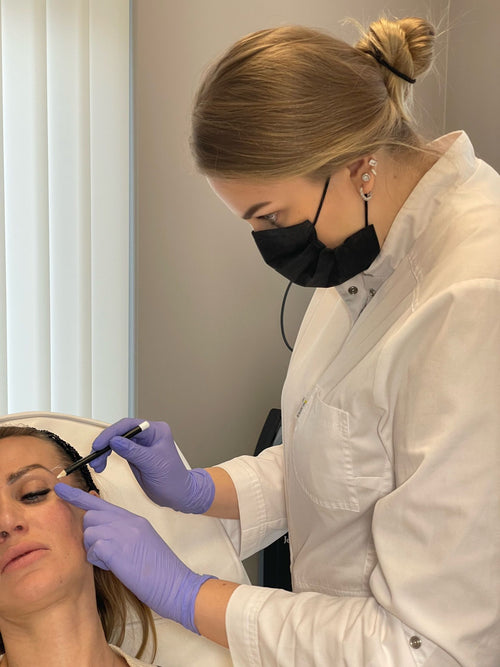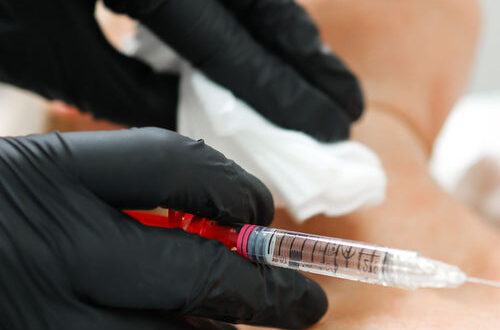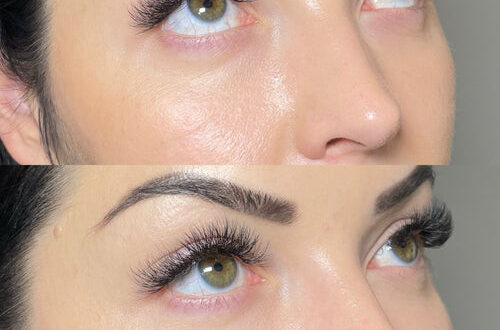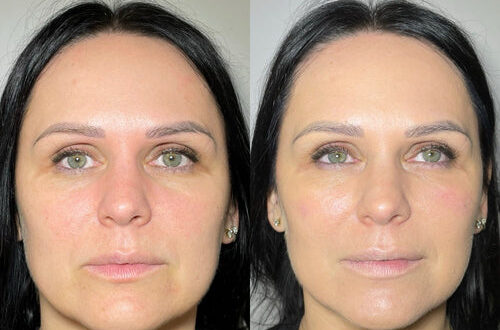Book Your Dermal Filler Session with Dr. Laura Geige Now
Telltale Signs
Swelling That Won’t Quit
Swelling following a filler injection is expected and typically subsides within a few days to weeks. However, persistent swelling that lasts beyond this timeframe could signal a potential issue.
Prolonged or excessive swelling may indicate a number of things, including improper placement of the filler, an allergic reaction, or infection. It’s essential to consult with your injector immediately if you experience swelling that doesn’t subside as expected.
Here are some telltale signs that your filler injection might be botched, particularly concerning persistent swelling:
**1. Unexpected Swelling:**
If the swelling is significantly more pronounced than what was discussed with your injector or is disproportionate to the area injected, it could be a sign of improper technique or excessive filler volume.
**2. Swelling That Doesn’t Resolve Within Weeks:**
As mentioned earlier, some degree of swelling is normal post-treatment. However, if swelling persists for more than two to three weeks, especially accompanied by other symptoms, it warrants investigation.
**3. Unnatural Lumps or Bumps:**
If you notice hard lumps or bumps under the skin that weren’t present before the injection, this could indicate filler has migrated or clumped together improperly.
**4. Asymmetry or Distortion:**
One side of your face becoming noticeably swollen more than the other, or a noticeable difference in facial contours compared to your pre-injection appearance, can suggest uneven filler distribution or improper injection technique.
**5. Pain, Tenderness, or Redness:**

These symptoms are common signs of an infection. If you experience them alongside persistent swelling, it’s crucial to seek medical attention promptly.
Remember, if you have any concerns about your filler results, don’t hesitate to contact your injector. They can assess the situation and recommend appropriate treatment or management strategies.
Reserve a Dermal Filler Appointment with Dr. Laura Geige
Asymmetry You Can Spot
Asymmetrical features can be a telltale sign that something might be amiss with dermal filler placement.
Pay close attention to your face for any discrepancies in symmetry. This could involve one cheek being fuller than the other, one eyebrow arching higher, or a noticeable difference in lip fullness.
An experienced injector will meticulously assess facial balance before administering fillers and aim for symmetry. However, subtle imbalances can occur even with skilled injection techniques.
If you notice any significant asymmetry after your filler treatment, it’s important to contact your injector as soon as possible.
Lumps and Bumps
Determining whether facial filler injections have gone wrong requires careful observation and often professional evaluation. While minor irregularities can be common, certain signs might indicate a complication requiring intervention.
Telltale signs of botched fillers include lumps or bumps at the injection site. These irregularities can feel hard, lumpy, or nodular under the skin. They may appear immediately after the procedure or develop over time.
Another potential sign is asymmetry. If one side of your face appears noticeably different from the other after filler injections, it could indicate uneven distribution or an improper injection technique.
Excessive swelling beyond a normal healing period can also be a red flag. Persistent swelling for more than a week or two might suggest that the filler has not been properly absorbed by the body or has caused inflammation.
Swelling that doesn’t subside and instead spreads to surrounding areas could indicate an allergic reaction or migration of the filler.
If you experience bruising that is excessive, prolonged, or accompanied by pain or tenderness, it’s important to consult with your injector or a medical professional.
Changes in sensation, such as numbness or tingling, can also occur after filler injections but should resolve within a few days. If these sensations persist or worsen, seek medical advice.
In rare cases, botched fillers can lead to vascular occlusion, which is when the filler blocks blood flow to tissues. This can cause discoloration of the skin, necrosis (tissue death), and require emergency medical intervention.
It’s crucial to remember that everyone responds to filler injections differently. What appears normal for one person might be concerning for another. If you have any doubts or concerns about your results, don’t hesitate to consult with a qualified medical professional who specializes in aesthetic injectables.
When to Seek Help
Beyond Aesthetics: Health Concerns
While many people seek dermal fillers for aesthetic enhancements, it’s crucial to remember that they involve injecting substances into your body. As with any medical procedure, there are potential risks and complications beyond simply not liking the outcome.
Therefore, knowing when to seek help goes beyond just dissatisfaction with the look of your fillers. You should always consult a qualified medical professional if you experience any of the following:
Pain or discomfort that is persistent or worsening after the initial swelling subsides.
Redness, warmth, or swelling that extends beyond the immediate injection site or doesn’t improve within a reasonable timeframe.
Hard lumps or nodules** forming beneath the skin.
Unevenness or asymmetry** in the treated area.
Blurry vision, double vision, or drooping eyelids** which may indicate complications affecting nearby nerves.
Difficulty breathing or swallowing**, which could signal a blockage or swelling of the airway.
Severe headaches or **facial pain.**
It’s important to note that these are just some potential signs of trouble. If you have any concerns at all about your fillers, regardless of how minor they may seem, it’s always best to err on the side of caution and seek professional medical advice.
Remember, early detection and treatment can minimize complications and ensure a better outcome.
Consult a Medical Professional
Knowing when to seek help after receiving dermal filler injections is crucial for ensuring the best possible outcome and minimizing potential complications.
While some minor swelling, bruising, and redness are normal after filler treatment, certain signs indicate a need for immediate professional attention.
Here are some situations where you should consult a medical professional:
-
Severe Pain or Discomfort: If you experience intense pain that doesn’t subside with over-the-counter pain relievers, seek medical attention immediately. This could indicate an allergic reaction, infection, or other complications.
-
Rapid Swelling or Redness: While some swelling is expected, sudden and excessive swelling or redness beyond the treated area could signify a severe allergic reaction or vascular compromise.
-
Blurred Vision or Double Vision: If you notice any changes in your vision after filler treatment, especially if accompanied by pain, it’s crucial to seek medical help promptly. This could be a sign of vascular occlusion, where the filler has blocked an artery supplying blood to the eye.
-
Numbness or Tingling: Persistent numbness or tingling in the treated area or surrounding tissues could indicate nerve damage or compromise.
-
Pus or Drainage: Any signs of pus or discharge from the injection site are indicative of infection and require immediate medical attention.
It’s important to remember that early intervention is key in addressing complications related to dermal filler injections.
If you have any concerns about your results, don’t hesitate to contact the practitioner who administered the treatment or seek a second opinion from another qualified medical professional.
Red Flags that Require Immediate Attention
Facial Paralysis or Numbness
Facial paralysis or numbness after dermal filler injection should be considered a serious medical emergency and requires immediate attention.
This can indicate a blockage or compression of nerves, blood vessels, or lymphatic vessels by the injected material.
Prompt medical intervention is crucial to minimize potential long-term damage.
Do not delay seeking help if you experience any of the following:
– Facial drooping on one or both sides
– Inability to smile, frown, or close your eyes fully
– Numbness or tingling sensations in the treated area or surrounding regions
– Pain, swelling, redness, or warmth extending beyond the injection site
Immediate action is essential because early treatment can often reverse or significantly reduce these complications. Delaying medical attention can lead to permanent nerve damage and facial deformities.
Contact your injector immediately if you experience any of these symptoms. If they are unavailable, go to the nearest emergency room without delay.
Difficulty Breathing
Difficulty breathing after dermal filler injections should be considered a serious medical emergency and requires immediate attention.
Filler migration, while concerning, doesn’t typically cause breathing difficulties. However, it could indicate that the filler has entered a blood vessel, leading to potentially life-threatening complications like an embolism or airway obstruction.
Arrange a Dermal Filler Consultation with Dr. Laura Geige
Immediate action is crucial in such situations. Seek emergency medical care without delay.
Other red flags that require immediate attention include swelling beyond the injection site, severe pain, fever, redness extending from the injection area, and signs of infection (pus, warmth, increasing pain).
It’s important to remember that even minor concerns after filler injections should be discussed with your injector. They can assess the situation and determine if further intervention is needed.
Vision Changes
Identifying a “botched” filler treatment can be tricky, as results often take time to settle and individual healing varies.
However, some immediate red flags signal potential issues requiring urgent attention:
- Severe pain or swelling that worsens over time: While some discomfort is normal initially, escalating pain or swelling could indicate infection or vascular complications. Seek medical attention immediately if this occurs.
- Visible lumps or bumps under the skin: Uneven or irregular filler placement can lead to noticeable lumps. This often indicates improper technique and may require professional intervention to dissolve and redistribute the filler.
- Asymmetry or distortion of facial features: If one side of your face appears significantly different from the other after treatment, it could suggest uneven filler injection. Immediate correction is necessary to prevent permanent asymmetry.
- Blurred vision or double vision: Filler migrating near vital blood vessels in the eye area can cause significant and potentially dangerous complications like blindness. Seek immediate medical attention if you experience any changes in your vision after treatment.
- Numbness, tingling, or coldness in the treated area: This could indicate nerve damage, which is a serious complication requiring immediate medical evaluation.
Vision changes are particularly concerning and must be addressed as an emergency. Do not delay seeking medical attention if you notice any alteration in your vision after filler injections.
Remember, it’s crucial to choose a qualified and experienced injector who prioritizes safety and uses high-quality products. If you have concerns about your results, consult with a board-certified plastic surgeon or dermatologist for professional guidance.
Reimagining Journalism Cycle for Azaylia Pinnacle Wellbeing Media Arielle Likes to Cook Pinnacle Wellbeing Media
- Alluzience Longer Lasting Botox Near Reigate, Surrey - May 4, 2025
- Botox Upper Face Wrinkles In Godalming, Surrey - May 2, 2025
- How To Make THC Beverages Last Longer In Your System - May 1, 2025





